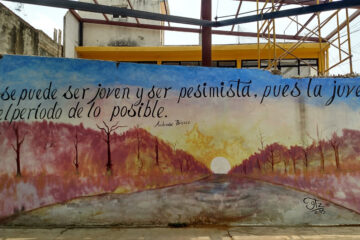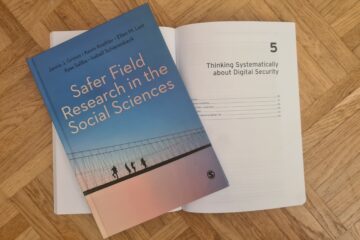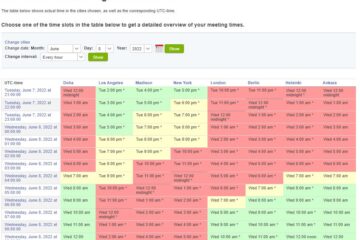by: Nicole Wilson, MIT
Like many other PhD students in comparative politics, over the past year I have been trying to figure out how to make progress in my work without traveling. Most of my research is focused on Lagos, Nigeria, and I had planned to spend part of 2020 collecting data there. For one project, my coauthors and I were going to run some focus groups, primarily to help us design an online survey about property tax compliance, but COVID made that impossible to do safely in person. Although there has been much discussion of Africa’s generally low rate of COVID cases,1 Lagos is a major urban center and was the hardest hit locale in the country. In March 2020, Lagos entered lockdown, banning large religious and social gatherings and closing schools and nonessential businesses. Even as restrictions were later eased in May and June, and life seemingly returned to normal for many, COVID remained a relevant concern, as it still does today.

Mural in Lagos, Nigeria, to encourage tax compliance.
I am working on this project with two co-PIs – Professor Lily Tsai and Leah Rosenzweig – and I was taking the lead on the logistics of the focus groups with our facilitator Adewoye Grace Oluwayemi.2 Our focus groups took place in October 2020, between the biggest waves of infection in Lagos,3 and by that point we could technically restart in-person research with the proper protocols per our institution’s IRB.4 However, since there was a lot of uncertainty about the true rate and about the future, I decided to plan to run the discussions fully remotely. Notably, this solution was possible in part because the population of interest for this project is middle- to upper-class residents of Lagos, most of whom I expected would have access to a stable internet connection. Although each of us had done research in Nigeria before, we were uncertain about how things in Lagos were operating differently with COVID, so I also consulted with local researchers about our approach. I settled on Zoom as the most appropriate platform, primarily because most people were likely to be familiar with it. I also valued reducing start-up costs by taking into consideration what both myself and our Nigerian facilitator were already comfortable with. Since I was teaching in March when everything suddenly went virtual, I had quickly gotten used to the ins and outs Zoom. Our facilitator was also familiar with it, having used Zoom for church conferences, academic lectures, and enumerator training for another survey project she helps manage. Finally, my coauthors and I were interested in incorporating multimedia to the online survey we were planning as part of the same project, and I liked the idea of using the focus groups to test out how people respond to these stimuli. Zoom screen sharing would easily allow this. Still, since most of the features across videoconferencing platforms are comparable, the choice was primarily about familiarity and comfort. Zoom also has international dial-in numbers, which theoretically could be an advantage to avoid data usage for respondents, but unfortunately in many countries – including Nigeria – it is a fee-based toll number that incurs a charge to both the participant and the host, requiring the purchase of an additional package. Having accessibility via phone rather than internet may be an important consideration for some projects.
During recruitment, which happened mostly by advertising through our existing contacts and networks, I asked participants if they would be able to join a Zoom call. Consistent with my expectations, most were already familiar with the software; by this point in the pandemic, it was commonly used for work, social, and religious gatherings, according to our participants. One older woman who was less familiar had her daughter set up the call for her and then leave the room. There ended up being a few minor connectivity issues here and there, but largely the sessions ran smoothly.

A sign on an infrastructure project, encouraging tax payment by linking revenue to public works.
Regarding recruitment, in some ways it should be easier to get people to participate in a Zoom focus group relative to one in-person. Since respondents don’t have to travel, the time commitment is lower and they don’t have to make transportation arrangements. As researchers we are not as constrained by geography in making sure everyone lives close enough to be able to get to one particular location. Still, recruitment was slow. While we had originally planned to have up to six focus groups until we reached a saturation point, I ended up only running two, the first with six people and the second with three. Importantly, recruitment was not the only reason we stopped after this point; we were also learning things that led us to reconsider our plan for the survey, and we wanted to make some changes before continuing. Having a relatively small number of participants made it harder to keep the groups homogenous to avoid unhelpful power dynamics among participants. On the other hand, we were already focusing on particular socioeconomic classes for this project, and ultimately everyone in the groups actively participated. I can’t say for certain how recruitment would have turned out differently absent COVID. My guess is it wouldn’t have been any easier, although the invitation to a focus group in a comfortable space with refreshments might have a certain draw that is difficult to replicate online.
Tax compliance is a potentially sensitive topic, although our prior experience had suggested to us that most people are willing to speak about it pretty freely.5 In some ways, the virtual setting might be well-suited to sensitive topics like this, since participants may feel more anonymous in the same way one does when writing in a comments section on social media platforms. I also invited participants to introduce themselves in whatever manner they wanted to be referred to in the discussion, which could include a nickname or alias. Participants could keep their video off if they preferred, and while this was framed primarily for bandwidth reasons, presumably this option would also be helpful for someone who actually preferred to remain hidden. I also described the subject of the focus group in the consent form that we distributed in advance, via WhatsApp and email, so all participants were informed and could ask questions about our goals before verbally consenting to participate at the start of the session.
In other ways however, especially among those who are suspicious of technology and the potential breaches of privacy it can bring, the virtual format may be difficult for sensitive topics. This is compounded by the difficulty of building rapport, and therefore a basic level of trust, when you are not in the same physical space as one another. This is true not only for the researcher-participant relationship, but also for the relationships among participants. In the past, I’ve often learned the most when talking to a group of people, each jumping in after the other, correcting, refining, supporting or disagreeing. But on a conference call, like a Zoom focus group, there is less of this back-and-forth. The barrier to jumping into a discussion is higher when you have to take an additional step to unmute yourself first.
There were also benefits to using video-conferencing technology like Zoom for a focus group. For instance, having the chat box available allowed people to drop in ideas that came to them without interrupting another or risking losing their thought, something not possible with an in-person group. It was important to set this norm of using the chat box at the beginning, along with some of the standard Zoom norms of staying muted, etc. There was take-up from participants, who often chimed in via chat to agree or disagree with what others were sharing, with some using it more than others. I or the other facilitator could follow-up on something said in the chat, using it to keep momentum in the discussion.

A screenshot from one of our focus group discussions, showing our amazing facilitator and the video we played.
Another advantage was the ability to easily integrate multimedia. I was able to share my screen, along with my computer’s audio, for one part of the discussion when I wanted participants to respond to a clip of a news story. Although doing this would be possible in an in-person discussion, it was certainly easier when we were all already on a phone or computer. I also chose a clip that would also work well as audio-only, in case some were looking at small screens on their phone or otherwise not able to see the video.
In addition to happening during a pandemic, our focus group sessions took place shortly after the Lekki Toll Gate Massacre, in which the Nigerian army fired on peaceful protestors who were denouncing police brutality as part of the #EndSARS movement, killing at least twelve6and injuring many more. In response, Lagos state issued a curfew and there were other demonstrations, fires, and general unrest throughout the city. This was a good reminder that even during “the before times,” there have always been events happening in the world, including in the places we do our research, that are beyond our control and potentially conditioning the phenomena in which we are interested. At the beginning of the focus group discussions, I was intentional about acknowledging the violence that had just occurred and created some space for participants to respond and process. However, the subject of our research was not police brutality, but tax compliance. As I’m sure most of us have felt in the past year, in the midst of crisis it can feel difficult to study something that is also important, but arguably less urgent, particularly from the perspective of participants in our focus groups, interviews, or surveys.
Finally, my co-facilitator and I had a lot of fun during the focus group sessions. She commented that it seemed like we all knew each other before the group. For me, working remotely and having more limited contact with others has been difficult. And although my own mental health is by no means my respondents’ burden to bear, the experience of human connection was a welcome side effect for me. Many of the respondents seemed to enjoy it, too, and even though I stressed confidentiality at the beginning, some even exchanged phone numbers with one another after I had officially closed the discussion. There is definitely room to iterate and improve, and it would be great to see more “best practices” emerge that take advantage of the platforms and features available. Also, many of the fundamental and ethical issues of doing fieldwork, including researcher positionality and power dynamics, exist in a virtual world at least as much as they do in person, and we must still grapple with them, even if our interactions feel more distant and removed. Yet in this case, where the virtual format was suitable for both the population and the subject matter, Zoom and similar technologies — that we are likely all more well-versed in now — can be a useful new tool in the toolbox.
Resources
Many of the resources I drew upon when preparing for these focus groups were not specific to the virtual format, since many of the same best practices apply (e.g., being explicit about norms at the start). I primary drew upon materials from notes and readings from a Qualitative Methods and Field Work course I took. The materials that I used are:
- Diana Kapiszewski, Lauren M. MacLean, and Benjamin L. Read. 2015. Field Research in Political Science: Practices and Principles. Cambridge University Press. Chapter 6 (“Interviews, oral histories, and focus groups”), pp. 190-233.
- Nikki Gambles. “The do’s and don’ts of using focus groups in prevention research” in Preventing disease and ill health, Blog of the Early Careers Forum of the European Society for Prevention Research (EUSPR): https://euspr.hypotheses.org/620.
- Richard A. Krueger. 2002. “Designing and Conducting Focus Group Interviews” http://www.eiu.edu/~ihec/Krueger-FocusGroupInterviews.pdf.
- Eliot & Associates. 2005. “Guidelines for Conducting a Focus Group” http://datainnovationproject.org/wp-content/uploads/2017/04/4_How_to_Conduct_a_Focus_Group-2-1.pdf.
In terms of the virtual format, I only later (after our focus groups) came across this resource, which includes some relevant material, including an entry by Nathan Browning about virtual focus groups that has some similar insights and additional references:
- Lupton, D. (editor) (2020) Doing fieldwork in a pandemic (crowd-sourced document). Available at: https://docs.google.com/document/d/1clGjGABB2h2qbduTgfqribHmog9B6P0NvMgVuiHZCl8/edit?ts=5e88ae0a#
I also noted that some existing resources about “virtual focus groups” are about asynchronous data collection via message boards/forums (Turney and Pocknee 2005) or email (Murray 1997) rather than synchronous videoconferencing.
- Turney, L., & Pocknee, C. (2005). Virtual focus groups: New frontiers in research. International Journal of Qualitative Methods, 4(2), 32-43.
- Murray, P. J. (1997). Using virtual focus groups in qualitative research. Qualitative health research, 7(4), 542-549.
- For more discussion on COVID-19 in Africa see https://www.devex.com/news/data-suggests-the-pandemic-is-playing-out-differently-in-africa-98204 or https://www.newyorker.com/magazine/2021/03/01/why-does-the-pandemic-seem-to-be-hitting-some-countries-harder-than-others
- Our team is grateful to the African Property Tax Initiative of the International Centre for Tax and Development for their generous support of this project.
- The peaks of new cases were around June 2020 and January 2021. The data is visualized here: https://www.worldometers.info/coronavirus/country/nigeria/ based on data from the Nigeria CDC (raw data here: https://covid19.ncdc.gov.ng/).
- Nigeria only requires approval for health research via the National Health Research Ethics Committee (NHREC), so our research did not require local research approvals.
- We also did not ask people to reveal their own history of tax (non-)payment, although several volunteered this information.
- According to Amnesty International. However, the government disputes that there were any deaths confirmed to be caused by army gunfire.


